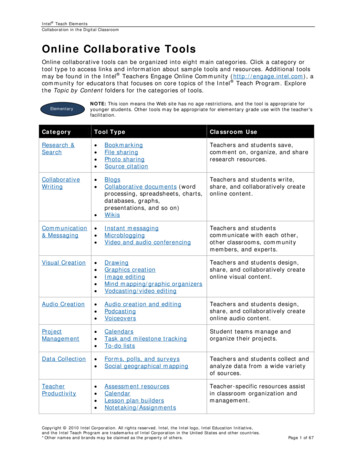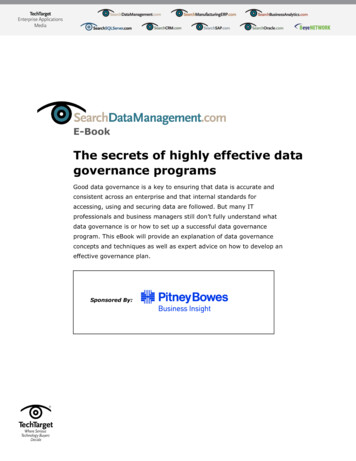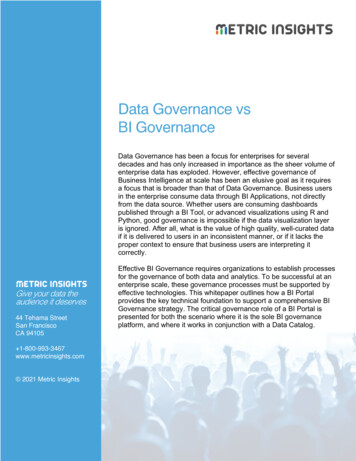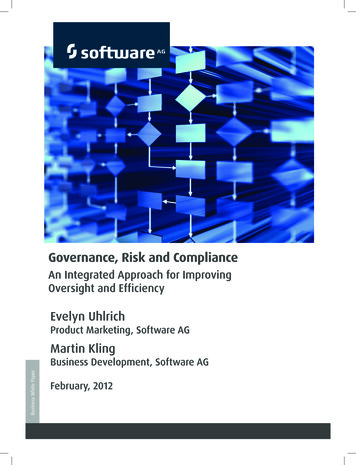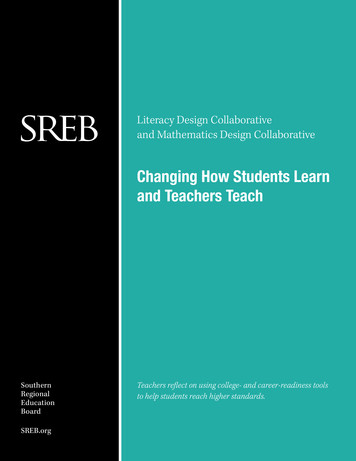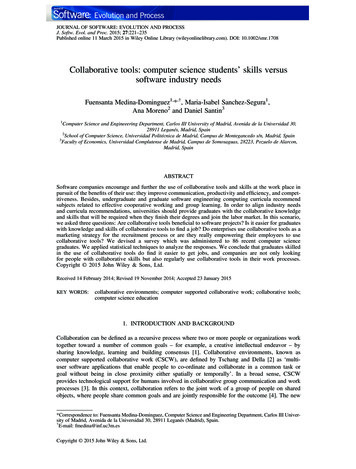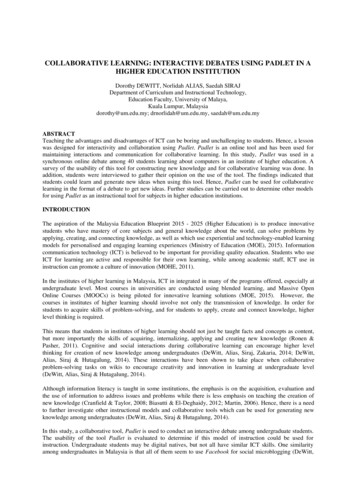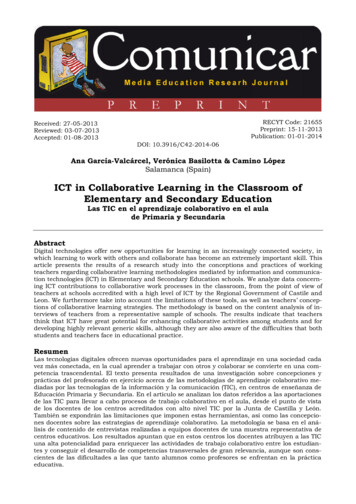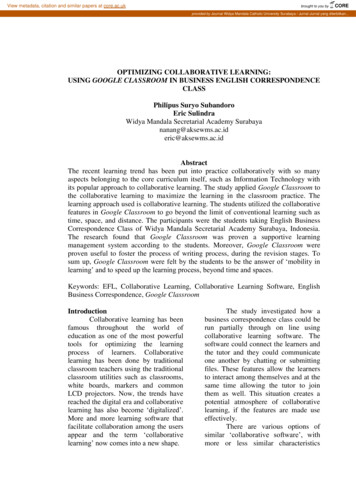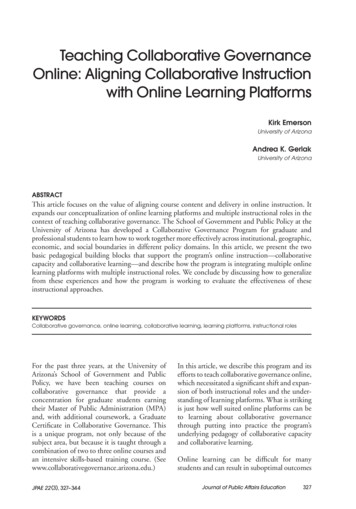
Transcription
Teaching Collaborative GovernanceOnline: Aligning Collaborative Instructionwith Online Learning PlatformsKirk EmersonUniversity of ArizonaAndrea K. GerlakUniversity of ArizonaABSTRACTThis article focuses on the value of aligning course content and delivery in online instruction. Itexpands our conceptualization of online learning platforms and multiple instructional roles in thecontext of teaching collaborative governance. The School of Government and Public Policy at theUniversity of Arizona has developed a Collaborative Governance Program for graduate andprofessional students to learn how to work together more effectively across institutional, geographic,economic, and social boundaries in different policy domains. In this article, we present the twobasic pedagogical building blocks that support the program’s online instruction—collaborativecapacity and collaborative learning—and describe how the program is integrating multiple onlinelearning platforms with multiple instructional roles. We conclude by discussing how to generalizefrom these experiences and how the program is working to evaluate the effectiveness of theseinstructional approaches.KEYWORDSCollaborative governance, online learning, collaborative learning, learning platforms, instructional rolesFor the past three years, at the University ofArizona’s School of Government and PublicPolicy, we have been teaching courses oncollaborative governance that provide aconcentration for graduate students earningtheir Master of Public Administration (MPA)and, with additional coursework, a GraduateCertificate in Collaborative Governance. Thisis a unique program, not only because of thesubject area, but because it is taught through acombination of two to three online courses andan intensive skills-based training course. (Seewww.collaborativegovernance.arizona.edu.)JPAE 22 (3), 327–344In this article, we describe this program and itsefforts to teach collaborative governance online,which necessitated a significant shift and expan sion of both instructional roles and the under standing of learning platforms. What is strikingis just how well suited online platforms can beto learning about collaborative govern ancethrough putting into practice the pro gram’sunderlying pedagogy of collaborative capacityand collaborative learning.Online learning can be difficult for manystudents and can result in suboptimal outcomesJournal of Public Affairs Education327
K. Emerson & A. K. GerlakBOX 1.Components of the SGPP CollaborativeGovernance ProgramTeaching and Training The Collaborative Governance concentration isoffered for MPA students and other pro fes sionalschools on campus. The Graduate Certificate in Collaborative Gov ern ance provides online instruction and work shoptraining for students and professionals on and offcampus and at a distance. Interactive seminars and workshops designed forspecific audiences are also available to extendthe capacity of those in the public and nonprofitsectors to work in complex networked settings,manage conflicts, and collaborate effectively.Projects and Service SGPP faculty work on a variety of service projectsto facilitate collaborative governance. These ef forts can include situation assessments; processor system design; evaluation, convening, andfacilitation; and mediation services.Research SGPP and other University of Arizona faculty studycollaborative governance and conduct researchon how collaboration works, how public-privatepartnerships and public service networks function,and how to improve collaborative governancesystems through design and evaluation, amongother research themes. This ongoing scholarshipcontributes to the quality of collaborativegovernance instruction as well as its effectivecollaborative governance practice.competencies (Emerson & Nabatchi 2015;Emer son, Nabatchi, & Balogh, 2012; Emerson& Smutko, 2011) as well as to demonstrate thevalue and enact the experience of collaborativelearning, an essential component of successfulcollaboration dynamics (Gerlak & Heikkila,2011; Heikkila & Gerlak, 2013).At first glance, this challenge appeared insur mountable, but as described in this article, theonline format required program faculty to ex pand their repertoire of instructional roles inorder to convey collaborative concepts anden gage students in learning about collaborativegovernance. In this article, we provide anoverview of the Collaborative Governance Pro gram, discuss the basic pedagogical buildingblocks of the curriculum, review some of therelevant challenges to online instruction, pre sent the program’s instructional roles and howthey are enacted, and conclude with currentand future efforts to evaluate student outcomes.OVERVIEW OF COLLABORATIVEGOVERNANCE PROGRAM SGPP also houses the National Institute for CivilDiscourse (NICD), an initiative directed by Caro lyn Lukensmeyer, to build civility and respectfuldeliberation among members of the U.S. Congressand within state legislatures, media, and thepublic (see http://nicd.arizona.edu).The 21st century workplace requires productivecollaboration across different organizations, pro fessions, and sectors. Executives, managers, andprofessionals, whether they work in the public,private, or nonprofit sector, are being asked tocollaborate with their colleagues down the hall,across town, and around the world. New skills,strategies, tools, and institutions are needed inorder to share resources, solve complex prob lems together, and leverage experience andknow ledge (Bingham, Nabatchi, & O’Leary,2005; Goldsmith & Eggers, 2004; Morse, 2010;Morse & Stephens, 2012).and high course attrition rates. Online instruc tion is often confined to delivering basic contentwith minimal complexity and nuance and min imal instructor interaction. Teaching colla bor ative governance online, however, is con sid er ably complex and nuanced, where the challengeis to activate students’ motivation to work acrossboundaries and strengthen their collaborativeCivic leaders and public managers must alsofoster cross-boundary collaboration in the pub lic arena, which has become increasingly polar ized and divisive. They are being called on toexpress themselves and represent others, par ti ci pate in work groups, task forces, and coalitions,and lead and serve on committees of stake hold ers with widely divergent interests and values.They must negotiate professional relationships,contracts, and employment dis putes as well asCivil Discourse328Journal of Public Affairs Education
Teaching Collaborative Governance Onlineengage with the public as public officials, com munity leaders, and voters. At home, at work,and in the public square, they need to be prac ticed in civil discourse, conflict manage ment,and collaborative leadership (Bryer & Cooper,2012; Crosby & Bryson, 2010; Gray, 1989;Huxham & Vangen, 2005; Mingus & Hori uchi, 2012; O’Leary, Choi, & Gerard, 2012).The practice of and scholarship on collaborativegovernance have skyrocketed in the past decade,leading the University of Arizona’s School ofGovernment and Public Policy (SGPP) todevelop a Collaborative Governance Program.The program is designed to meet the growingneeds of government, nonprofit, and corporatemanagers who are seeking better ways to worktogether across institutional, geographic, eco no mic, and social boundaries in many differentpolicy domains, such as natural resource man agement, public health, urban planning andeconomic development, and energy and publicutilities (Ansell & Gash, 2007; Bryson, Crosby,& Stone, 2006; Carlson, 2007; Emerson et al.,2012; Gerlak, Lubell, & Heikkila, 2013; O’Leary& Bingham, 2007).The SGPP Collaborative Governance Programbuilds on the experience and expertise of mul tiple instructors, practitioners and re searchersworking across four program areas summarizedin Box 1.In this article, we focus on the three onlinecourses summarized in Box 2 that were dev eloped as part of the core for the graduateMPA concentration and the Graduate Certi ficate in Collaborative Governance. These coreonline courses are accompanied by several of fer ings in skill building delivered in a classroomor workshop format. For more informationon the overall Collaborative GovernancePro gram and the graduate curriculum, seewww.collaborativegovernance.arizona.edu.As happens with many innovations, serendipityand timing led to the development of theseonline courses: funding from the University ofArizona’s Outreach College to encourage dis tance learning opportunities within the grad uate curriculum became available just asEmerson and Smutko (2011) completed theirreport on collaborative competencies for theUniversity Network for Collaborative Govern ance. At the time, the challenges for teachingcollaboration online were not fully appreciatedand were counterbalanced in any event by theopportunity to start building the program andmaking it accessible not only to the school andthe university community but to otherinstitutions and distance learners.BOX 2.Summaries of Three Online Course Offeringsin Collaborative GovernancePA 620A Collaborative Governance in Theory,Practice, and Research provides students witha foundation in collaborative governance: theunderlying theories that support it; how it is practicedin various policy arenas; and recent findings fromresearch to improve its use. In this course, studentscritique the use of collaborative governance indifferent case studies, apply principles of practiceto simulated contexts, and develop alternativecollaborative approaches to hypothetical orcontemporary governance challenges.PA 622A Institutional Design and Learning forCollaborative Governance provides an in depthexploration of institutions and learning in colla borative governance. Attention is devoted to thediversity of institutional structures and processes;key elements and features of institutional design;collaborative learning and innovation; and mattersof institutional performance in cross-boundarycollaborative governance that takes place ininteragency, intergovernmental, cross-sector, andcivic engagement settings. This course featuresa broad range of cases, including economicdevelopment, human services, health care,education, environmental policy, biotechnology,and emergency planning.PA 624A Collaborative Governance Tools introduces students to the array of tools and technologiesavailable to assist cross-boundary governance andcollaborative management, including tools for pro ject coordination, information sharing, know ledgemanagement, visioning, public engagement, con flictmanagement, collaborative geographic informationsystems (GIS), participatory budgeting, decisionsupport systems, and collaborative monitoring.Journal of Public Affairs Education329
K. Emerson & A. K. GerlakBOX 3.Collaborative CompetenciesLeadership and Management Competency1. Strengthening Collaborative Leadership, for example: Effective leadership roles Collaborative leadership styles and skills Political and entrepreneurial skills2. Planning, Organizing and Managing for Collaboration, for example: Designing and managing collaborative problem solving and conflict resolution processes Planning and building collaborative networks, partnerships, and cross-sector institutions Designing and sustaining deliberative civic engagement and public participationProcess Competency3.Communicating Effectively, for example.: Listening skills Presentation, persuasion, and assertiveness Communicating in different modes and media to different kinds of groups Cross-cultural communication skills4.Working in Teams and Facilitating Groups, for example: Understanding group dynamics and building working relationships Facilitating group deliberation and decision making Participating in teams effectively5.Negotiating Agreement and Managing Conflict, for example: Two-party negotiation and conflict management styles Interest-based negotiation and conflict resolution in multiparty settings Managing conflict constructively in groups in different rolesAnalytical Competency6.Applying Analytic Skills and Strategic Thinking, for example: Situation assessment and issue analysis Understanding the political, legal, and regulatory context for collaboration Decision analysis for negotiation and agreement seeking7.Evaluating and Adapting Processes, for example: Measuring outcomes and impacts of collaborative processes Setting group goals and indicators of success for performance evaluation Assessing and adapting ongoing progressKnowledge Management Competency8. Integrating Technical and Scientific Information, for example: Assessing information requirements for informed decision making Developing methods and standards for collecting and analyzing information9. Using Information and Communication Technology, for example: Using computer-based decision support and spatial analysis tools Using Web-based communications and social networking toolsProfessional Accountability Competency10. Maintaining Personal Integrity and Professional Ethics, for example: Enacting/enforcing principles of fairness, transparency, and inclusive engagement Reflecting on personal and professional effectiveness and seeking feedback Balancing personal, professional, and institutional obligations with group orcross-sector organizational requirementsSource. Taken from Emerson and Smutko (2011).330Journal of Public Affairs Education
Teaching Collaborative Governance OnlineBUILDING BLOCKS: COLLABORATIVECAPACITY AND COLLABORATIVE LEARNINGThe design of the SGPP Collaborative Govern ance Program rests on two basic pedagogicalbuilding blocks: collaborative capacity andcollaborative learning. Across the program,through the various courses, instructors aretrying to activate students’ appreciation andmotivation to work across boundaries and tostrengthen their collaborative competencies todo so. While “collaboration is becoming the21st century’s governance tool of choice andnecessity” (Emerson & Smutko, 2012, p. 5), itrequires proficiencies in management andparticipation that are not fully recognized norbroadly realized (see Box 3).These five collaborative competencies (and 10skill sets) are consistent with guidance from theliterature on graduate management education,including network management functions (e.g.,Agranoff & McGuire, 2001), collaborativeskills needed by emergency managers (e.g.,Alexander, 2003), entre pre neurial strategies forinterorganizational managers (e.g., Page, 2003),general capabilities for public managers (e.g.,Bingham, Sandfort, & O’Leary, 2008), andknowledge and skills relevant to local deli ber ative practice (e.g., Carcasson & Bruns, 2009).In combination, the courses offered in the SGPPprogram work to build all these competencies.“The capacity for joint action,” as specified byEmerson and Nabatchi (2015), who draw onmultiple frameworks for collaboration found inthe literature (Agranoff & McGuire, 2001;Ansell & Gash, 2008; Bardach, 1998; Brysonet al., 2006; Cooper, Bryer, & Meek, 2006;Thomson & Perry, 2006; Wood & Gray,1991), is a crucial component of collaborationdynamics and needs to be built and sustainedover time across partners in collaborativegovernance. Those joint capacities includeinstitutional and procedural arrangements,resources, knowledge, and leadership (Emerson& Nabatchi, 2015, p. 68). To train tomorrow’scollaborative managers, the SGPP programtries to provide students with an understandingof the value and variety of these capacities aswell as the skill base to practice and improvetheir own collaborative competencies.The program’s second building block iscollaborative learning. Due to the complexityof the problems and organizational dynamicsoften associated with collaboration, the capacityfor learning is an important feature for theendurance and success of collaborative arrange ments (Ansell & Gash, 2007; Gerlak & Heikkila,2007; Pennington, 2008; Weber, Lovrich, &Gaffney, 2005).Drawing upon a wealth of literature—rangingfrom organization theory, policy process andchange, and network analysis—Gerlak andHeikkila (2011) established a framework ofcollective learning to guide inquiry aboutlearning in collaborative governance settings.The framework guides the study of howlearning processes and products are linkedwithin a collaborative setting and providesinsights into the structural, social, andtechnological features of collaboration thatmay foster or impede learning. Subsequentresearch has expanded these ideas to applymore generally to diverse collective contextswhere policy decisions are debated, devised,implemented, and enforced, paying moreexplicit attention to the relationship betweenindividual and collective learning as well asexploring in-depth the phases of the learningprocess and the factors that shape learning(Heikkila & Gerlak, 2013). (See Figure 1.)Building from this research, the SGPP programpositions learning as a central dimension of itsinstructional program; learning is explicitly thefocus of the PA 622A course, as indicated in itstitle—Institutional Design and Learning forCollaborative Governance. This courseintroduces students to classic readings, such asSenge’s (2006) “learning organization” andWenger’s (1999) “communities of practice.”Students also become familiar with strategies tolearn from failure (Edmondson, 2011), thelarger role of information and technology insupporting learning in collaborative settings,and how learning processes in collaborativesettings can support more adaptive governance.Journal of Public Affairs Education331
K. Emerson & A. K. GerlakFIGURE 1.Linking Individual Learning to Learning Processes and Products in Collective Policy ContextsIndividual Learning ProcessIndividual Learning ProductsCollective Learning ProcessAcquireTranslateDisseminate(knowledge, info, experience)Collective Learning ProductsCognitive(new beliefs or ideas)which may lead to:Behavioral (new strategies, plans,programs, rules policies)Policy ProcessesSource. Based on Heikkila and Gerlak (2013, p. 487).In addition to its focus on substantive learning,the Collaborative Governance Program alsoembraces a learning approach to programevaluation and to making adjustments andadaptations over time. This is in line withresearch positing that collaborative capacitygenerates associated adaptive capacity, therebyenabling adaptation within collaborative govern ance regimes (Emerson & Gerlak, 2014).CHALLENGES FOR ONLINE INSTRUCTIONSeveral general challenges affect learning andparticipation in online coursework. Attritionrates in MOOCs (massive online open courses),for example, are widely documented, as is thedecline in students’ active participation inonline courses over the course of a semester(Clow, 2013; Yang, Sinha, Adamson, & Rose,2013). The claim (often used as an incentive)that up-front investments by instructors inonline course development will translate into332Journal of Public Affairs Educationless teaching workload during the rest of thesemester has proven false and can lead todiminished student-teacher interaction. Thesechallenges, along with inadequate institutionalsupport around hardware and software andtrain ing in course design and development(Nkonge & Geuldenzolph, 2006), have con tri buted to making online instruction far lessgratify ing for many instructors than face-toface classroom interaction. These and otherexperiences with online teaching over the past5–10 years have discouraged many high-qualityteachers from experimenting with onlinecourses. Nonetheless, the trend toward Webbased learning continues to accelerate (Kraiger,2014; Sitzmann, Kraiger, Stewart, & Wisher,2006). This trend is in line with instructor rolesin course delivery that are changing morebroadly for both traditional and online courses(Keengwe & Kidd, 2010).
Teaching Collaborative Governance OnlinePerhaps the most significant challenge foronline learning is the distance between thestudents and the instructor created by the inter vening Web platform. Asynchronous teachingunits leave students on their own to engagewith the material when convenient for them,without direct and immediate interaction withinstructors. While bringing flexibility andautonomy to students’ learning practices, thisinteraction deficit can be problematic, as notedby the growing literature on instructors’ socialpresence, or the lack thereof, in online courses(Garrison & Cleveland-Innes, 2005; Picciano,2002). More blended learning or hybridinstructional models of instruction that inte grate face-to-face with online learning exper iences are one approach to mitigating some ofthis distance (Keengwe & Kidd, 2010).A second challenge for online learning isstudent discomfort or lack of familiarity withthe course technology. Students need to befamiliar with the technology used in the courseto be successful (Belanger & Jordan, 2000;Wojciechowski & Palmer, 2005). Earlierresearch suggests that students who reportfrustration with technology in online coursesgenerally report lower satisfaction levels withthe course (Chong, 1998).A third challenge involves the diversity asso ciated with the online classroom. Onlinecourses are generally thought to enroll a moreheterogeneous population of learners—in termsof student preferences, skills, and needs—thantraditional college students who take classes oncampuses (Phipps & Merisotis, 1999). Thegreat degree of diversity within the onlinestudent population (Cheung & Kan, 2002) canrelate to professional expertise, age, gender, andculture, among other factors. This turns out tobe the case for the University of Arizona SGPPstudent population as well.ALIGNING ONLINE LEARNING PLATFORMSWITH NEW INSTRUCTOR ROLESThe Collaborative Governance Program onlinecourses have attempted to address and mitigatethese challenges to online learning while at thesame time drawing out the opportunitiesavailable through online technology to buildcollaborative capacity and collaborative learn ing. To do so, the program faculty had toexpand their understanding of what onlinelearning platforms are. They are far more thanthe course website itself and its structure. Thisstatic perception reinforces the view that onlinecourses are simply “serve ’em up” courses,transferring content from the classroom to theWeb, where more students can access infor mation at will.We came to conceptualize learning platforms asa complement of stages or spaces for learningthat connect through a course architecture. Forour purposes, those platforms all enhancecollaborative learning and interactivity. Thelearning platforms we identified are the coursesyllabus and its structure; the course website;the online content, including narrated Power Point presentations (termed e-talks), videopresentations, and accessible references; inter active assignments, communication flows, theclass community itself, interactions with theinstructor; and the integration of the contentinto the students’ knowledge base and pro fessional repertoire. These learning plat formshave much in common with the multifacetedcontexts in which professional managers findthemselves. In public conflict settings or incross-sector collaborative govern ance arenas,professionals must take the initiative to assessthe available information, access multiplesources of additional infor mation, consult withtheir colleagues and with experts, engage withstakeholders, manage com munications withthe public, analyze and integrate what theyhave learned, and recom mend paths forward.To orchestrate these platforms, several addi tion al instructional roles are required tofacilitate the students’ encounters, not onlywith the content and requirements of thecourse, but with their classmates, the instructor,and their own learning experiences. Thesemultiple roles extend beyond the conventionalrole of content delivery, conventionally prac ticed in the lecture hall or the classroom. Ratherthan serving only as the expert source ofknowledge, program faculty had to designlearning platforms in which students take onJournal of Public Affairs Education333
K. Emerson & A. K. GerlakTABLE 1.Instructor Roles and Learning PlatformsLearningplatformsCourse syllabusand structureInstructor ltantXXXXCourse website designOnline content: e-talks,video, referencesXXXXXConnectorXXInteractive assignmentsXCommunication flowXXClass communityXXXXXXXXXXInstructor interactionXIntegrationXXXXNote. An X indicates how the instructor role maps with the course architecture.the responsibility for acquiring and synthesizingknowledge themselves, usually from multiplesources and media, not just the instructor’slecture notes or PowerPoint slides. For theCollaborative Governance Program onlinecourses, we identified additional roles for theinstructor: as designer of learning platforms, asrole model, as learning consultant, and asconnector. All these roles support the multiplelearning platforms in multiple ways, as illus trated in Table 1 and the following discussion.Instructor as Designer of Learning PlatformsIn designing these multiple online learningplatforms, the instructor creates a facilitativelearning environment and serves as an accessibleon-call expert consultant for students. Thisdesigner role extends well beyond what mostinstructors in academia do when designing334Journal of Public Affairs Educationtheir syllabi for lecture courses. Conventionally,instructors organize the content and producelectures and connections to textbooks for thestudent to then follow and demonstrate masteryof. Public affairs instructors, however, are muchmore familiar with creating learning platformsin their applied practice courses, where studentswork in teams and produce deliverables and theinstructor serves as consultant when needed.And those instructors who teach skills-basedcourses, like negotiation and conflict manage ment and leadership, also know how to stage arole-play or simulation, assembling neededinformation, managing student role assignments,stimulating student engagement, and creatingtimelines for preparation, practice and selfreflection. Online instructional design is farmore like the latter instructional model thanthe former conventional one.
Teaching Collaborative Governance OnlineThe most significant opportunity for teachingcollaboration online resides in the designchal lenge of creating new learning platformsthat enable students to appreciate the value ofcollaboration, understand the components orworking parts of collaboration, and experiencecollaboration with other students. Effectively,the instructor becomes a shadow partner withthe students as they experience collaborativelearning by design. The existing scholarshipsuggests that there is no discernible differencein learning outcomes, or students’ perceptionsof their learning, between traditional face-toface university courses and well-designed and-delivered online courses (Braun, 2008; Rovai& Jordan, 2004; Topper, 2007). Nonetheless,instructors need to be “careful not to assumethat teaching the same in both environmentswill create similar results” (Mullen & TallentRunnels, 2006, p. 264).As previously described, the SGPP collaborativegovernance curriculum includes three onlinecourses and one skills-based course. Specificcollaborative skills are best developed throughactive practice and feedback in interactiveexercises, role-plays, and simulation activitiesin a classroom or workshop setting. That said,the online courses are designed not only todeliver content about collaborative governancebut also to foster collaborative engagement inthe learning process. The program strives tobuild in community development and inter activity between the instructor and among thestudents, which researchers have highlighted ascritical for successful online distance programs(Rofe, 2011).The course website itself is the online classroomand, like its physical counterpart, it influencesthe interaction between instructor and students.The website’s graphic design and the arrange ment of course components as they appear onthe computer screen convey a sense of organ ization, clarity, consistency, openness andacces s ibility, and dynamism and inter act ivity.The standard template require ments andDesire2Learn (D2L) software for online coursesat the University of Arizona con strain the website appearance and architecture to some extent.However, within those limita tions, the programhas tried to create a con sistent graphic appearance across all collaborative governance coursesand to make the site as user-friendly as possible.As one example, Figure 2 presents a Wordle oncollaborative governance that appears through out the courses.The weekly online discussion forums describedbelow are designed to foster deliberative dis course. Guidelines and grading rubrics provideincentives for students to take these discussionforums seriously. Earlier research suggests thatwhen students engage one another in onlinediscussions in a focused way, their behaviorsenhance learner outcomes (Wilson, Pollock, &Hamann, 2007). In the program courses, earlydiscussion assignments help the students getacquainted with each other (posting picturesand biographical information) so that thesubsequent substantive discussions build oninterpersonal bonds. For example, in all threeonline courses, students are asked at the outsetabout their personal and professional exper iences, as well as their goals and where theyexpect to see themselves in five years.The team presentations toward the latter half ofthe Collaborative Governance in Theory, Prac tice, and Research (PA 620A) course requirestudents to collaborate in designing onlinepresentations, creating discussion questions,and curating the discussion forum for the weekof their presentation. For the InstitutionalDesign and Learning for Collaborative Govern ance (PA 622A) course, the final group projectgives students the opportunity to develop theirown collaborative design to address a com munity or regional public policy issue in needof co
PA 624A collaborative governance Tools intro- duces students to the array of tools and technologies available to assist cross-boundary governance and collaborative management, including tools for pro- ject coordination, information sharing, knowledge management, visioning, public engagement, con flict
